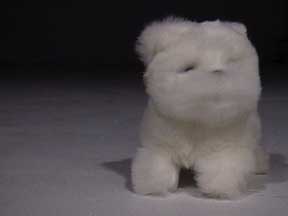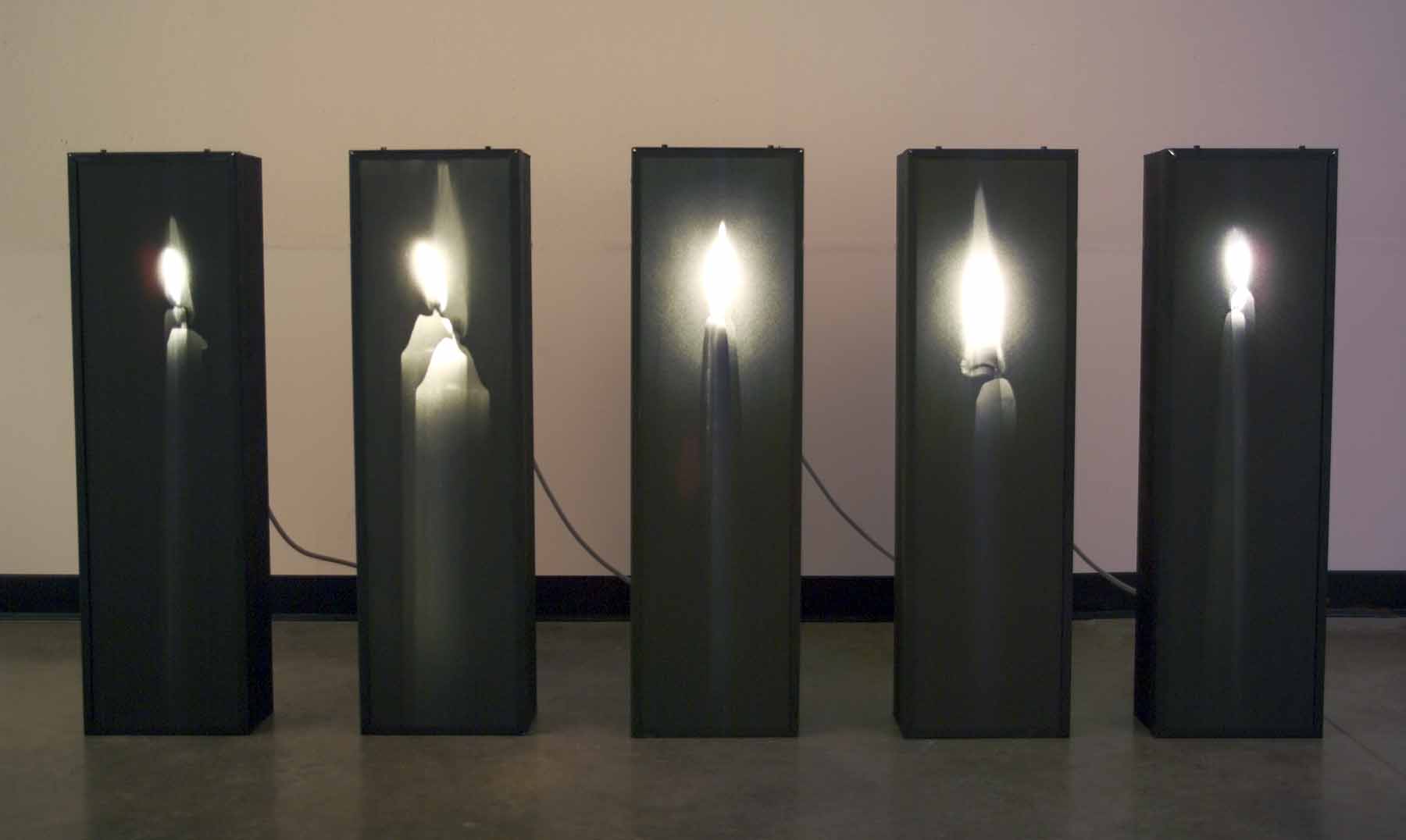Visible Fringe F-Stops: The Thorp Building, Dreams, Big Candles, Love
Alex Starace checks out the art at the Thorp Building (1620 Central Avenue), one of the ten venues exhibiting visual arts as a part of the Minnesota Fringe Festival.


In order to find the installation And then I Woke Up and It Was All a Dream you have to walk through hallway after hallway of what feels like an abandoned warehouse, nobody in sight, only ancient vending machines and hand-made signs that point you onward, past closed industrial offices and sawdust-filled corners. Finally the trail reaches a door: you’ve made it. You fiddle with the handle and find it to be locked. A woman sitting on a couch, reading a book – herself a complete non-sequitor, and the first person you’ve seen since entering the building – looks up and says, “Oh, you’re here to see the art,” and unlocks the door and lets you in.
You find yourself inside an enormous, unlighted, vacant munitions factory, sixty yards wide, with two enormous wall-sized videos projected on either side of the rectangular room, both images boring down on you. One is a stuffed, wind-up dog, walking towards you, barking a cutsy, electronic bark and the other is a stuffed, wind-up cat, walking towards you, meowing a cutsy, electronic meow. You’ve found it: this is And then I Woke Up and It Was All a Dream.
Helen Stringfellow and Lars Boye Jerlach’s installation initially evokes a feeling of dream-like surreality, but, like much of the rest of the art in the Thorp Building, the hunt is a good deal more satisfying than the kill. In the case of Stringfellow and Jerlach’s work, there’s a marked lack of sophistication. The curator’s notes describe the monstrously-sized stuffed animals as “playing on common narratives of cat versus dog, male versus female, love versus hate,” and while this is a decidedly accurate assessment, it also reveals the problem: And then I Woke Up rehashes in a uselessly broad manner already-considered cultural dichotomies and does little else. As a result, it feels intellectually empty, hollow; it’s just love and hate, male and female, and while such an approach may be a temporary crowd-pleaser – the themes are extremely easy to identify, after all – its lack of ingenuity means it quickly becomes dismissible, boring.
Equally underwhelming is Eric William Carroll’s installation Big Candles (Future Memorial), which takes up an entire room and consists of five large light-boxes that display photographs of candles. Each box is lit by a fluorescent light placed directly behind the image of the flame. Great meaning is supposed to be found in the fact that these ‘artificial’ candles are the only source of light in the room, but this only highlights how hopelessly generalized the piece is: without the context of Carroll’s other work or some sort of narrative, it’s nearly incoherent.
Big Candles could be read as a commentary on modernity, or on mourning, or on the endurance of the hope for peace . . . or perhaps it attempts to encapsulate all three? The curator’s notes mention that the piece has many, many possible interpretations. It seems the title also suffers from this problem: it’s difficult to tell if it’s tongue-in-cheek or entirely earnest, and such vagueness leads the piece, as a whole, to feel like a cipher, like nothing more than a series of objects placed in a room.
Much more thought-provoking and focused is Jes Schrom’s series of photographs, Anatomy of a Love Letter. The piece itself is not actually a part of the installations in the Thorp Building, but rather is exhibited in “Fringe Redux,” the festival-wide store that happens to be located in the same building. Regardless, Anatomy of a Love Letter does everything the installations don’t do: it’s directly specific, highly bizarre in its originality, and complex enough to both answer and create questions.
The piece is a series of twenty-one photographs, mounted in a row on a wall. Each photo is about a foot and a half square and consists of an enlarged, nearly microscopic close-up of either ice, condensation, rocks, snow, water, or some combination of the five. Intriguingly, it’s quite easy to figure out what’s being shown in the series of photographs, but impossible to authoritatively identify one image: a bubble on water looks like a bit of ice, which looks like a pebble; the elements of the earth and sea are both discrete and inseparable, at once identifiable and confusing. Their title, Anatomy of a Love Letter, sleekly focuses our attention: the fact that a letter – not just love itself, but the admission of love – is composed of distant, scientifically-presented geological occurrences complicates and confuses the notion of true-destiny, Romeo-and-Juliet love. In other words, Is the seemingly personal need to discuss love nothing more than an impersonal force of the earth? Maybe, but the piece is not an overt rejection of romance, either: love letters are, after all, compared to life-sustaining (and quite beautifully rendered) phenomena. It seems that they, like condensation and sublimation, can be both transcendent and mundane.
Admittedly, the idea that love (and things related to love) is confusing, natural, and difficult to describe is not new. But Schrom’s presentation of the idea, her insight into it, and the beauty of the images she provides certainly is new. Unlike the installations described earlier, Schrom’s piece digs at the depths of a commonly held truism, excavates small but glimmering insights and shows the complexities of the commonplace – she gives us something new by providing us greater understanding of something we already know. For this, Anatomy of a Love Letter is one of the few pieces in the Thorp Building that is not only fun to search for, but also worth finding.